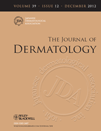Quantitative effect of face washing on cutaneous resident microbiota in female subjects who wear make-up
Corresponding Author
Shigeki Numata
Departments of Dermatology, Fujita Health University School of Medicine, Toyoake, Japan
Correspondence: Shigeki Numata, M.D., Department of Dermatology, Fujita Health University School of Medicine, 1-98 Dengakugakubo, Kutsukake-cho, Toyoake, Aichi 470-1192, Japan. Email: [email protected]Search for more papers by this authorHirohiko Akamatsu
Departments of Applied Cell and Regenerative Medicine, Fujita Health University School of Medicine, Toyoake, Japan
Search for more papers by this authorNarifumi Akaza
Departments of Dermatology, Fujita Health University School of Medicine, Toyoake, Japan
Research Laboratories, Nippon Menard Cosmetic, Nagoya, Japan
Search for more papers by this authorYasuyuki Sasaki
Research Laboratories, Nippon Menard Cosmetic, Nagoya, Japan
Search for more papers by this authorShiori Takeoka
Research Laboratories, Nippon Menard Cosmetic, Nagoya, Japan
Search for more papers by this authorHiroshi Mizutani
Research Laboratories, Nippon Menard Cosmetic, Nagoya, Japan
Search for more papers by this authorSatoru Nakata
Research Laboratories, Nippon Menard Cosmetic, Nagoya, Japan
Search for more papers by this authorKayoko Matsunaga
Departments of Dermatology, Fujita Health University School of Medicine, Toyoake, Japan
Search for more papers by this authorCorresponding Author
Shigeki Numata
Departments of Dermatology, Fujita Health University School of Medicine, Toyoake, Japan
Correspondence: Shigeki Numata, M.D., Department of Dermatology, Fujita Health University School of Medicine, 1-98 Dengakugakubo, Kutsukake-cho, Toyoake, Aichi 470-1192, Japan. Email: [email protected]Search for more papers by this authorHirohiko Akamatsu
Departments of Applied Cell and Regenerative Medicine, Fujita Health University School of Medicine, Toyoake, Japan
Search for more papers by this authorNarifumi Akaza
Departments of Dermatology, Fujita Health University School of Medicine, Toyoake, Japan
Research Laboratories, Nippon Menard Cosmetic, Nagoya, Japan
Search for more papers by this authorYasuyuki Sasaki
Research Laboratories, Nippon Menard Cosmetic, Nagoya, Japan
Search for more papers by this authorShiori Takeoka
Research Laboratories, Nippon Menard Cosmetic, Nagoya, Japan
Search for more papers by this authorHiroshi Mizutani
Research Laboratories, Nippon Menard Cosmetic, Nagoya, Japan
Search for more papers by this authorSatoru Nakata
Research Laboratories, Nippon Menard Cosmetic, Nagoya, Japan
Search for more papers by this authorKayoko Matsunaga
Departments of Dermatology, Fujita Health University School of Medicine, Toyoake, Japan
Search for more papers by this author
REFERENCES
- 1Akaza N, Akamatsu H, Sasaki Y et al. Cutaneous Malassezia microbiota of healthy subjects differ by sex, body part and season. J Dermatol 2010; 37: 786–792.
- 2Gao Z, Perez-Perez GI, Chen Y, Blaser MJ. Quantitation of major human cutaneous bacterial and fungal populations. J Clin Microbiol 2010; 48: 3575–3581.
- 3Rosenthal M, Goldberg D, Aiello A, Larson E, Foxman B. Skin microbiota: microbial community structure and its potential association with health and disease. Infect Genet Evol 2011; 11: 839–848.
- 4Ikeda N, Nakayama M, Sasagawa K, Ito M, Kato Y. Variations in the counts of epidermis resident flora during a daily facial hygienic treatment. J Antibact Antifungal 1984; 22: 193–198.
- 5Toshima Y, Ojima M, Yamada H et al. Observation of everyday hand-washing behavior of Japanese, and effects of antibacterial soap. Int J Food Microbiol 2001; 68: 83–91.




